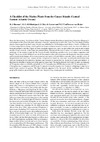Identificador persistente para citar o vincular este elemento:
https://accedacris.ulpgc.es/jspui/handle/10553/49778
| Título: | A checklist of the marine plants from the Canary Islands (Central Eastern Atlantic Ocean) | Autores/as: | Haroun, R. J. Gil-Rodríguez, M. C. Díaz de Castro, J. Van Reine, W.F. Prud'homme |
Clasificación UNESCO: | 251004 Botánica marina | Palabras clave: | Genus Dictyota Phaeophyceae Reproductive Morphology North-Atlantic Rhodomelaceae Rhodophyta Mediterranean Seaweeds, et al. |
Fecha de publicación: | 2002 | Editor/a: | 0006-8055 | Publicación seriada: | Botanica marina (Print) | Resumen: | Since the last century, the richness of the Canary Islands marine flora has attracted many botanists. Borgesen's seminal papers have been the main reference source for anyone interested in this flora. The first checklist of the marine macroalgae from the Canary Islands was published by Gil-Rodriguez and Afonso-Carrillo (1980a) with 434 macroalgal species being listed together with some dubious records. In recent years, the research efforts of local phycologists and the output of some scientific expeditions have yielded some new species and a large number of new records to the Canarian seaweed flora. The aim of this contribution is to compile an up-to-date catalogue of the marine plants for the Canary Islands (including cyanobacteria, macroalgae, seagrasses and fungi). The review of all published records of these marine plants takes into account the present taxonomic status and nomenclatural changes of the taxa concerned and rejects old and dubious records. After a careful review of the pertinent references and revision of live and preserved material, only valid records published before July 2001 are included in this checklist. Besides, each species is quoted for the islands in an cast-west fashion to illustrate the distributional pattern of the species concerned. The marine flora of the Canary Islands is composed of 711 species, which are distributed as follows: 59 Cyanophycota, 385 Rhodophycota, 125 Chromophycota, 117 Chlorophycota, 3 seagrasses and 22 fungi. Compared to nearby regions, the Canarian archipelago comprises a much larger number of species. Ibis high diversity appears to be the result of the combined effects of its geographic location, paleoclimatic events and the prevailing oceanographic conditions. | URI: | https://accedacris.ulpgc.es/handle/10553/49778 | ISSN: | 0006-8055 | DOI: | 10.1515/BOT.2002.015 | Fuente: | Botanica Marina [ISSN 0006-8055], v. 45, p. 139-169 |
| Colección: | Artículos |
Citas SCOPUSTM
102
actualizado el 08-jun-2025
Citas de WEB OF SCIENCETM
Citations
91
actualizado el 18-ene-2026
Visitas
333
actualizado el 15-ene-2026
Descargas
631
actualizado el 15-ene-2026
Google ScholarTM
Verifica
Altmetric
Comparte
Exporta metadatos
Los elementos en ULPGC accedaCRIS están protegidos por derechos de autor con todos los derechos reservados, a menos que se indique lo contrario.
